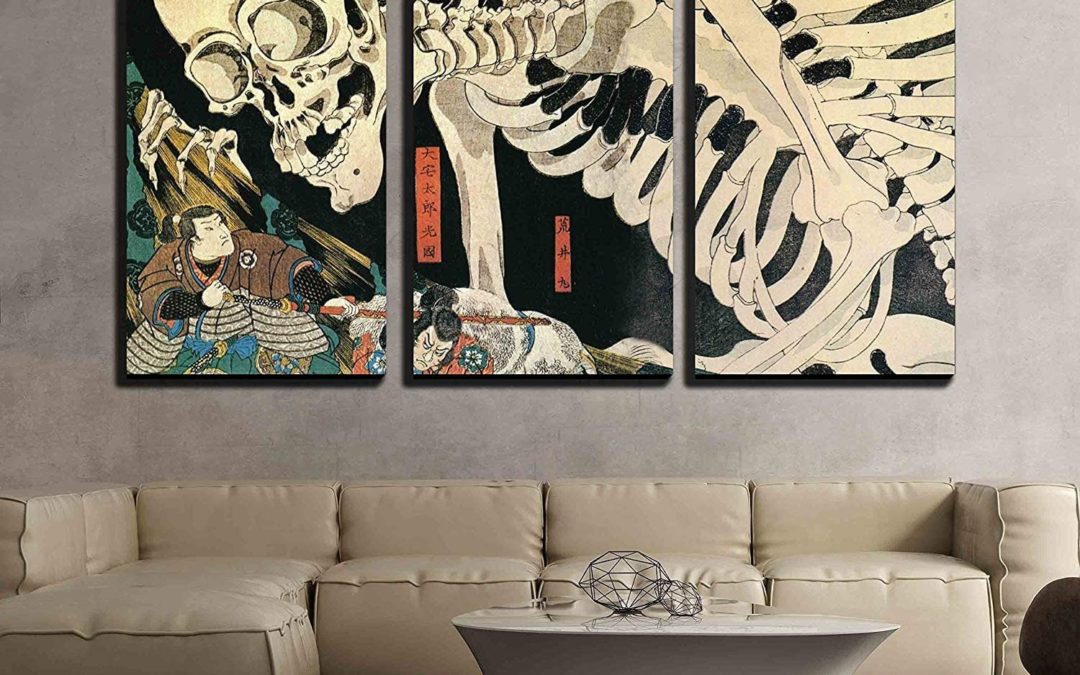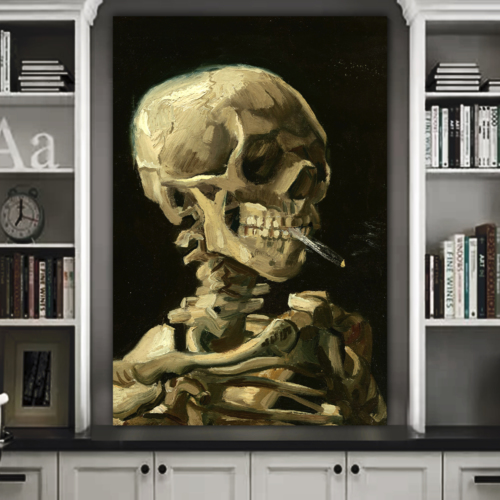It’s growing ever close to Halloween! Is there an image more symbolic of this spooky season than that of the skeleton? Skeletons are made of several hundred bones and gives us the foundation to move around and live life how we see fit! Many people would be surprised to know that the bones that comprise the skeleton are actually living tissue! It is understood by most people that bones have the ability to repair themselves after breaks our fracturs, but did you know that they are actually constantly rebuilding themselves in responses to everyday activity? We bet you didn’t know that! Want to learn more about skeletons? Read below for skeleton wall art facts!
Number
It is common knowledge for many that the adult human skeleton is comprised of 206 individual bones. Were you aware that not all humans have 206 bones? Babies are born with over 300 bones, most made from cartilage! As a baby ages into a toddler, this cartilage is mineralized thus turning hard and fusing together. Aside from babies, some people are born with extra bones. There are people with a 13th pair of ribs. There are even people born with fully developed and functional extra toes and fingers. There even exists people who develop extra bones during their lives. Studies have shown that the fabella, a bean-shaped boned located at the back of the knee is becoming bigger and more prevalent in the human body due to improved nutrition around the world. Read below for more skeleton wall art facts.
Height
The change in height for a child progresses rapidly, until height growth finally stops in the late teenage years. Did you know that even when our bones stop growing, our height is still subject to change? Joints are spaces in the body where two bones meet. Between joints is a layer of cartilage covering the bones. Cartilage is rubbery tissue that is comprised of water and collagen. Over the course of a day the cartilage between your joints is compressed by the pressure of gravity. This means throughout the course of the day, you are progressively getting shorter! By the time you go to bed, you are actually shorter than you were when you woke up that morning. When laying down for the night, our spines decompress thus starting the process all over again. The effects of height due to gravity are inversed in space; astronauts have reported being 3% taller once situated outside of Earth. Read below for more skeleton wall art facts.
Connections

Did you know that there’s only one bone in the body that isn’t connected to another bone? This one exception is the hyoid bone. The hyoid bone is shaped like a “U” and sits at the base of the tongue. This bone is held in places by the muscles and ligaments that comprise the base of the skull and jawbones. The hyoid bone is what allows humans to talk, breathe and even swallow! Due to the positioning of this bone, it’s very rare to break naturally. Post-mortem examinations by medical professionals attest to only finding the hyoid broken if it was done through strangulation or hanging. Read below for more skeleton wall art facts.
Marrow
All bones are filled with bone marrow, which is made of fat, blood and immune cells. In children, bone marrow is the color red; this reflects its important role in producing red blood cells. In adults, however, bone marrow is yellow and contains around 10% of the fact in an adult human body. For a long time, scientists and medical professionals thought that bone marrow was only useful for children, considering that adult bone marrow doesn’t play a primary part in the production of red blood cells. However, professionals have come to discover that adult yellow bone marrow is actually very important! This fatty marrow helps the metabolism function regularly, which keeps the entire human body running. Read below for more skeleton wall art facts.
Small
Ever wondered what the smallest bones in the human body are? Well, we’re here to tell you. The smallest bones are the malleus (hammer), incus (anvil), and the stapes (stirrup). Altogether, these bones are known as the ossicles which translates to “tiny bones” in Latin. Wondering what they do? Their role is transmitting sound vibrations from the air to the fluid located within the inner ear. Aside from being the smallest bones in the body, they also have one particularly unique trait. After the age of one, they are the only bones in the body that do not experience any form of growth or reformation. Why not? This is due to their function; a change in shape to these bones would affect the way that someone hears. The ossicles are also important in the study of archaeology; looking at these in a particular skeleton can give clues about its birth mother’s diet and general health. Interesting, huh? Did you enjoy these skeleton wall art facts?
Conclusion
In the spirit of Halloween, many people regard skeletons as being really creepy. After all, they are all that’s left after a person dies and decomposes. That said, do you find skeletons more interesting now that you know these facts? Are you amazed by the changes that bones undergo throughout life, or even throughout the span of a day? Are you shocked by the specific functions that some bones perform? However you feel, we just hope that you learned something from reading this blog! Thanks for reading these skeleton wall art facts!





